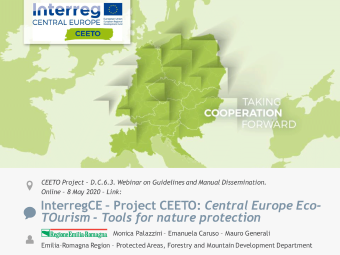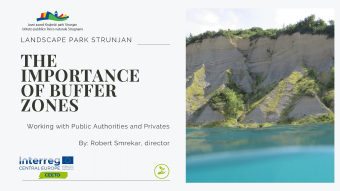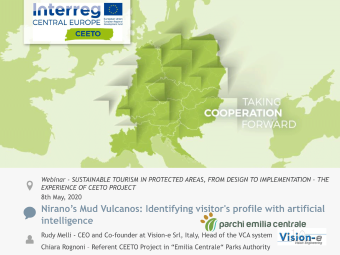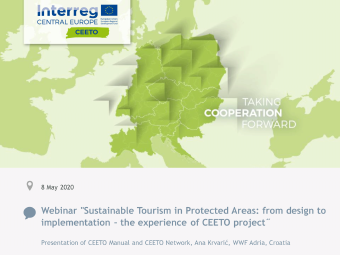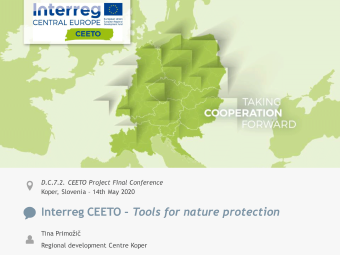Webinar on Sustainable Tourism in Protected Areas: from design to implementation - the experience of CEETO project
In this webinar, we presented two useful tools developed within CEETO project to guide Protected Area Managers and Policy Makers on Sustainable Tourism implementation, as well as two case studies related to both levels of action.
On May 8th 2020, 11:00 CET, the last webinar produced within the CEETO project agenda before the project closure was presented to a broad audience of more than 260 participants from 66 countries. The event was organised jointly between CEETO representatives and EUROPARC Federation, and targeted both decision makers of Protected Areas at policy level and management level.
Below you can find a brief summary of the webinar contents and download the presentations displayed by the speakers or watch the webinar recording:
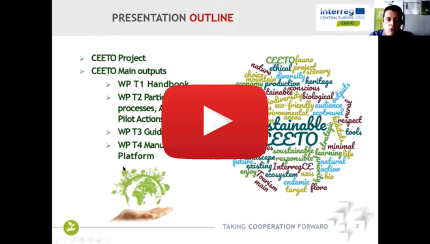
Watch the webinar recording
CEETO Project Overview
The webinar started with a presentation done by Mauro Generali, Technical and Communication Manager at the Emilia-Romagna Region, Italy - Lead Partner of the CEETO project. Mauro explained the main objectives of CEETO, the participatory planning approach that the project has implemented to design Sustainable Tourism Action Plans in 8 Pilot Protected Areas of Europe and the target groups involved in the project. Furthermore, he introduced the two levels of action that CEETO project targets, policy and management, in order to give the floor to two case studies.
Case Study: The Importance of Buffer Zones: Working with Public Authorities and Privates
Presented by Robert Smrekar, L.L.M. - Director of the Public Institute Landscape Park Strunjan, Slovenia, through this case study we learned how buffer zones are useful to reduce the impact of tourism. The presentation started with an introduction to Landscape Park Strunjan, the importance of developing a common strategy for Sustainable Tourism implementation and the necessity of engaging local authorities in understanding the low revenue that mass tourism brings to the park.
Robert provided also a more detailed overview on the tourism characteristiques of Landscape Park Strunjan and the existing issues related with over-tourism, such as traffic jams and seasonality. Continuing, a descripiton of the pilot action implemented was presented, which consisted in the creation of two buffer zones at two main entrances of the park, the Belvedere Terraces entrance and the Strunjan Landscape Park main entrance. The specific actions involved were traffic regulation; provision of electric minibuses, cofinanced by CEETO project, along with bus routes and timetables as an alternative to private car utilisation; and visitor awareness and campaigns.
The presentation concluded with a review of the lessons learned, the effectiveness of buffer zones and common issues existing between managers, businesses and local authorities.
Case Study: Nirano’s Mud Volcanoes: Identifying visitor's profile with artificial intelligence
Presented by Rudy Melli – CEO and Co-founder at Vision-e Srl, Italy, Head of the VCA system. In this case study, Rudy started with an overview to the Nirano’s Mud Volcanoes Nature Reserve, including conservation and protection measures, and the objectives of the Pilot Action developed in it in the framework of CEETO project and some of the Environmental Education for Sustainable Tourism Actions carried out (like the Protected Areas Open Day). Following, an in deep description of the Monitoring Tool NEMOS – Nature Reserve Monitoring System that uses Artificial Intelligence, was presented together with the implementation of management activities for its deployment. This included Reserve`s stakeholders involvement, monitoring design and the definition of the monitoring process parameters such as timeframe, location, communication to local community, data analysis and budget. The presentation also included examples of videos and images of reference and main utilities that the system provides.
CEETO Manual for Protected Area Managers
Presented by Ana Krvarić, CEETO Project Coordinator at WWF Adria, Croatia, who provided an overview of the CEETO Manual of Sustainable Tourism Governance for Protected Area Managers. This is an operational document that aims to improve the managing capacities of Protected Area managers and local stakeholders and implement an actual sustainable use of nature and its assets.
The presentation included the target audiences, a summary of its contents: guiding principles and international framework, Information for Sustainable Tourism development, case studies from around Europe including CEETO case studies and additional literature. The CEETO Manual of Sustainable Tourism Governance for Protected Area Managers . The presentation ended with an overview of the CEETO Network and Platform, another main CEETO outcome, its functionalities and an invitation to participants to join in.
CEETO Guidelines for Policy Makers
Presented by Tina Primožic, CEETO Manager at Regionale development center Koper, Slovenia. The last presentation of the webinar provided an overview of the CEETO Guidelines for developing a Sustainable Tourism in Protected Areas. This document has been designed in the framework of CEETO project as a tool to support policy makers at international, national and regional level in the process of shaping the tourism planning and management within and around Protected Areas. Tina's presentation included an antecedents on how the Guidelines have been created, its target audiences and a summary of the document structure and its objectives.
Discussion
After all the presentations, a discussion round was open in which the participants could ask, either live or using the platform chat box, specific questions regarding the presentations or the topics at matter. A high number of participants showed interests for the NEMOS monitoring system. Furthermore, questions regarding the case study of Strunjan Landscape Park were asked, with specific question regarding marine traffic management and the priorities on the buffer zones.
To end with, an invitation to the CEETO Final Conference was sent to all the attendees in order to inform about the event and offer the opportunity to register.
